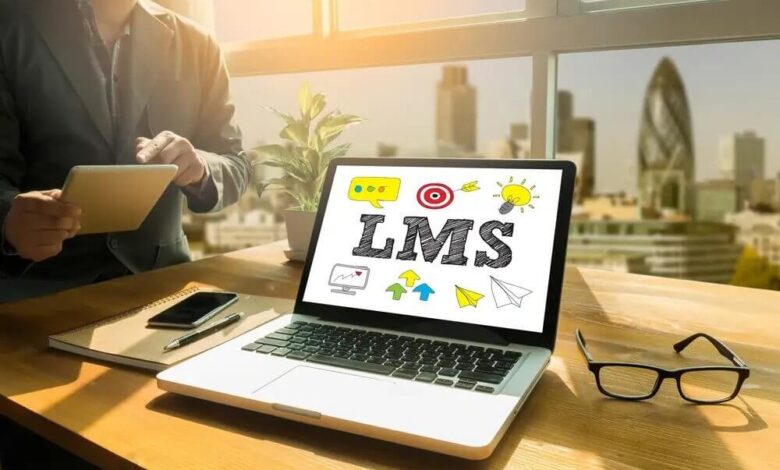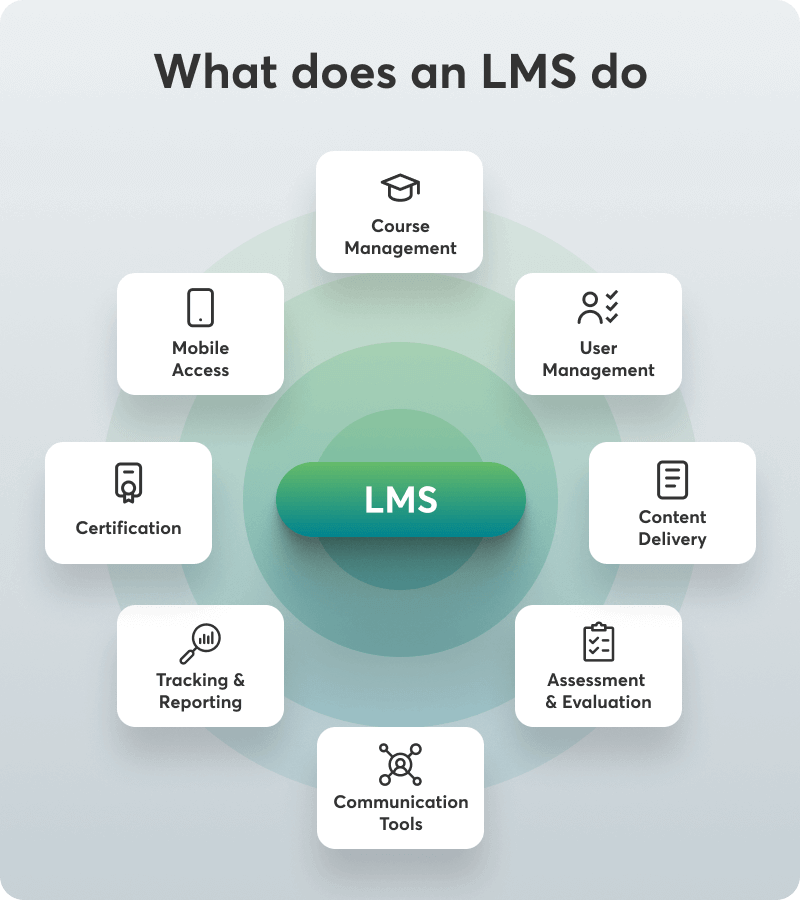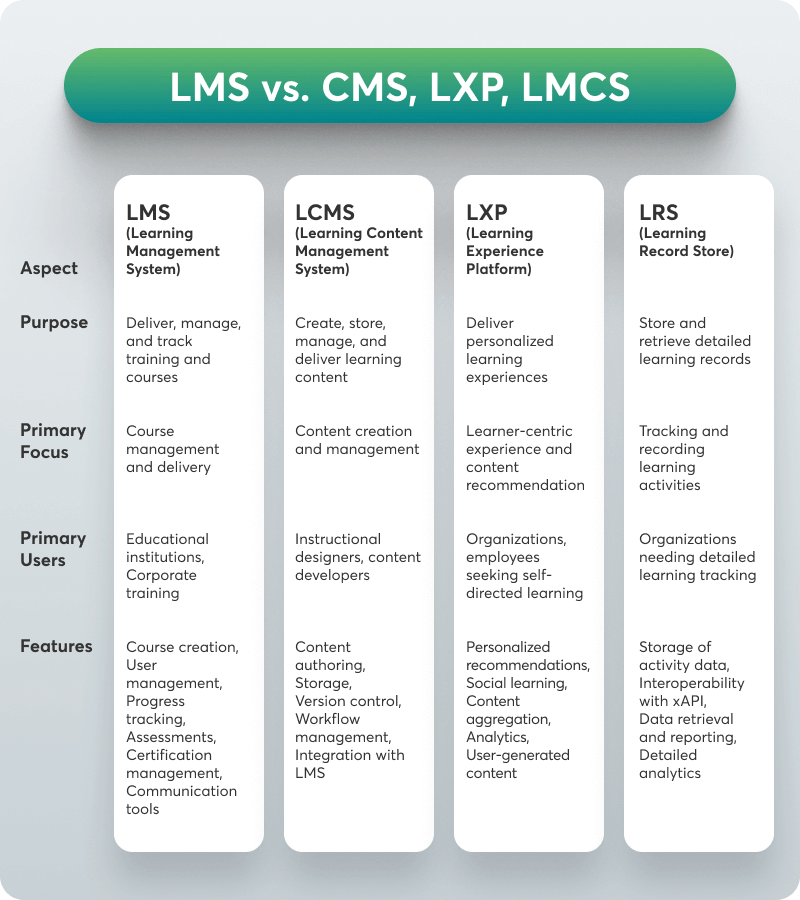What is an LMS (Learning Management System)?

In today’s digital age, the way we learn and train has been transformed by technology, and at the heart of this transformation is Learning Management Systems (LMSs). An LMS is a versatile tool that helps educators, trainers, and organizations manage and deliver educational content efficiently.
From schools and universities to corporate training programs and government agencies, the use of LMS platforms has revolutionized the approach to teaching and learning. The demand for online and blended learning is growing rapidly, as is the size of the LMS market, which is expected to reach 69.6 billion by 2030.
Because of this, understanding the role and benefits of an LMS becomes essential, especially for educators and online instructors. This article explains what an LMS is, its benefits and different types, and how you can choose the right one for your business!
P.S. If you are looking for an LMS, check out our list of the best Learning Management Systems in the market.
What is a Learning Management System (LMS)?
A Learning Management System (LMS) is a powerful software application that can help you plan, manage, and deliver elearning content.
An LMS is a tool that facilitates the administration, documentation, tracking, reporting, and delivery of educational courses or training programs. It is used widely in the eLearning industry and is a great management and distribution vehicle for learning programs across various sectors.
LMSs support synchronous (live) and asynchronous (self-paced) learning, providing tools for creating interactive content, conducting assessments, and monitoring learner progress. This technology has become essential in modern education and training, enabling efficient and effective learning experiences tailored to the needs of diverse users.
Use cases of learning management systems
The role and functions of LMS software vary depending on the learning goals of the instructor or company that is using it, and ultimately the industry they are in.

These are the most common categories of individuals and organizations that utilize an LMS:
Schools / Academic Institutions
A school or any other academic or learning institution uses an LMS to help teaching professionals assign online learning, share educational resources and materials (assessments, ebooks, quizzes), and manage student grades.
In many cases, it aids the education management of a K-12 school, as it can monitor student enrollments, keep records up-to-date, store students’ information, including their contact details, and track learner progress.
![]()
Note
The popular tool Microsoft Teams is not an LMS—as might be considered mistakenly—but can be integrated into one.
Virtual and Elearning-based Learning Associations
Online institutions such as LinkedIn Learning, Udemy, and Khan Academy allow people to grow their skills through online courses and professional development programs. These are not considered free LMSs but learning marketplaces.
Corporate Training Departments
Small businesses, medium-sized companies, and large enterprises that want to offer employees an easily accessible and standardized learning environment as a training solution where they learn and grow at their own pace purchase LMSs.
A Corporate Learning Management System (LMS) can streamline the training management process, helping you build an online corporate training program that covers your training needs. It can also make the onboarding process for new employees a lot easier.
Nonprofit Organizations
Nonprofit organizations often don’t have the appropriate resources to train volunteers effectively. Using an LMS as a training platform can help standardize the training process and make it available and accessible to all internal stakeholders.
Nonprofits also leverage LMS systems to sell online courses as an additional revenue source to support their mission.
Content Providers
Content providers create training content, promote it, and sell it. With the right LMS that offers multiple monetization options, any course instructor can create, manage, and sell educational content to those interested in boosting their knowledge or skills in any field.
Wholesale Companies
An LMS can keep distributors, resellers, and internal sales teams up-to-date with the latest products and promotions. It also enables collaborative learning among internal (existing employees or new hires) and external stakeholders (learners) through tutorials, webinars, and other collaboration tools and interactive learning activities.
Why use a learning management system?
With an LMS, you can plan, manage, and deliver training content for different purposes depending on who you are or who you represent. You can also use it to track online training initiatives.
These purposes may serve different functions in any of these settings:
Educational institutions: An LMS offers an open, user-friendly, and flexible learning environment that creates personalized learning paths for students, delivers online course modules, and even supplements real-time in-class instruction. This works as part of a blended learning setting where face-to-face instruction is still offered at schools, colleges, and universities.
Corporate training: HR resources administration initiatives in an organization use an LMS as a training tool. It can be part of talent management or the onboarding process, employee training, partner training, member training, compliance training, and sometimes sales enablement. The most prominent industries include healthcare/medicine, sales/marketing, software, and tech.
Customer training: Some companies want to educate customers on how to use their products in addition to educating their staff. These companies use an LMS to allow their customers to learn about their product or service—what they sell and how it works. This reduces support calls and increases engagement and product satisfaction.
Extended enterprise training: Similar to what they do for their customers, companies offer online training resources to external sales channels, partners, and franchisees.
Freelancing: LMSs are also used by people who want to monetize knowledge. They create and sell online courses by teaching what they know, establishing a viable or additional source of income as freelance online instructors. These guys or gals are also known as edupreneurs.
As you can see, an LMS can carry out all of these activities and be used in different ways to achieve a unique outcome. It sounds like the ultimate multi-tool!
The benefits of using an LMS
Using an LMS has its advantages, but this depends much on the features it offers. Every LMS is different because of what it can do for you.
According to the Encyclopedia of Distributed Learning, the six elements that make up the LMS concept are interoperability, accessibility, reusability, durability, maintenance ability, and adaptability.
So, generally, every LMS can:
Provide access to learning material on the go.
Offer flexibility in individual learning pathways.
Offer easy and fair evaluation based on attendance and assessment.
Use many learning materials (text – PDF, image, audio, video, templates, etc).
Support elearning materials from one or various sources (SCORM, xAPI, AICC, LTI, Cmi5).
Track progress and provide an analysis of user learning.
Measure learning impact and performance success.
Automate the learning process.
Diving into more specifics, though, it can do all of the following for learners, businesses, and schools:
LMS benefits for learners
Ensure they’ve been delivered and are up-to-date with required training.
Make formal and informal learning easily accessible.
Attain the skills and knowledge required to develop professionally.
Boost workplace productivity through the boost of performance.
LMS benefits for businesses
Reduce learning and development costs.
Decrease training time and improve productivity and overall performance (workers, consumers, and external partners).
Engage and expand to diverse learning audiences.
Organize training resources from one central location.
Assess learner progress and corporate performance.
Measure knowledge retention.
LMS benefits for schools/educational institutions
Track the time it takes students to complete assessments.
Manage multiple classes or groups with assignments, scorings, and data tracking using only one tool.
Incorporate more interactive elements into your learning programs.
Introduce ways to communicate with each other and the instructor, saving valuable time.
What are the different types of LMSs?
Even though an LMS can do many great things, not every LMS can do everything. There are many categories of LMSs because each specializes in certain aspect(s) or seems to serve a specific purpose better than others.
LMSs differ in terms of:
Deployment type
Pricing
Licensing
Specifications
Customer types
The following table gives you a quick overview of the different types of LMSs available.
Certainly! Here’s the table with the provided data, formatted according to your template:
LMS Type
Deployment Type
Pricing Model
Licensing
Specifications
Customer Type
Open Source LMS
Open Source: Free version with open and adaptable source code. (e.g. Moodle)
Free, with possible costs for additional services and plugins.
Free License
Often supports SCORM, Tin Can API/xAPI, AICC, LTI, and CMI-5.
All types – depends on customization.
Commercial Cloud-based
Cloud-based (SaaS): The vendor hosts all data; no installation is required, and there are automatic updates and vendor support (e.g., LearnWorlds).
Subscription (monthly/yearly) or pay per user.
Paid License
Often supports SCORM, Tin Can API/xAPI, AICC, LTI, and CMI-5.
Enterprise, Corporate, Academic.
Self-hosted LMS
Self-hosted: The customer purchases a license and maintains the LMS on their server without vendor support.
Pay per learner/user, license fee.
Paid License
Supports SCORM, Tin Can API/xAPI, AICC, LTI, and CMI-5.
Enterprise, Corporate.
Desktop Application
Desktop Application: Works as a desktop app, some may support smart devices for team collaboration.
Pay per user license fee.
Paid License
Varies, may support common eLearning standards like SCORM.
Enterprise, Corporate.
Mobile Application
Mobile Application: Accessible on smartphones, allows for uploading learning content on the go.
Subscription (monthly/yearly) or pay per user.
Paid License
Often supports mobile-friendly formats, may include SCORM or xAPI.
Enterprise, Corporate.
Custom-built LMS
Custom-built: Tailor-made system built and maintained by in-house or contracted developers.
Pay-as-you-go, development and maintenance costs.
Varies (often proprietary).
Can be designed to support any required eLearning standards.
Specific to the organization’s needs.
Industry-specific LMS
Industry-specific: Developed for a specific industry, includes relevant training assets like certifications and training activities.
Varies (subscription, pay per user).
Paid License
Typically supports industry-relevant formats and standards (may include SCORM).
Specific industries (e.g., healthcare, aviation).
Partner LMS
Varies: May be cloud-based, self-hosted, or custom-built, targeting partner training.
Varies (subscription, pay per user).
Varies (often paid).
Supports standards like SCORM, Tin Can API/xAPI to facilitate partner training.
Enterprise.
Enterprise LMS
Varies: May be cloud-based, self-hosted, or custom-built, targeting enterprise training.
Varies (subscription, pay per user).
Varies (often paid).
Supports standards like SCORM, Tin Can API/xAPI to facilitate comprehensive training.
Enterprise.
Corporate LMS
Varies: May be cloud-based, self-hosted, or custom-built, targeting corporate training.
Varies (subscription, pay per user).
Varies (often paid).
Supports standards like SCORM, Tin Can API/xAPI to facilitate corporate training.
Corporate.
Academic LMS
Varies: May be cloud-based, self-hosted, or custom-built, targeting academic institutions.
Varies (subscription, pay per user).
Varies (often paid).
Often supports standards like LTI, SCORM, Tin Can API/xAPI to facilitate academic learning.
Academic institutions.
Deployment Type
Pricing Model
Licensing
Specifications
Customer Type
Open Source LMS
Open Source
Free, with possible costs for additional services and plugins.
Free License
Often supports SCORM, Tin Can API/xAPI, AICC, LTI, and CMI-5.
All types – depends on customization.
Commercial Cloud-based
Cloud-based (SaaS)
Subscription (monthly/yearly) or pay per user.
Paid License
Often supports SCORM, Tin Can API/xAPI, AICC, LTI, and CMI-5.
Enterprise, Corporate, Academic.
Self-hosted LMS
Self-hosted
Pay per learner/user, license fee.
Paid License
Supports SCORM, Tin Can API/xAPI, AICC, LTI, and CMI-5.
Enterprise, Corporate.
Desktop Application
Desktop Application
Pay per user license fee.
Paid License
Varies, may support common eLearning standards like SCORM.
Enterprise, Corporate.
Mobile Application
Mobile Application
Subscription (monthly/yearly) or pay per user.
Paid License
Often supports mobile-friendly formats, may include SCORM or xAPI.
Enterprise, Corporate.
Custom-built LMS
Custom-built
Pay-as-you-go, development and maintenance costs.
Varies (often proprietary)
Can be designed to support any required eLearning standards.
Specific to the organization’s needs.
Industry-specific LMS
Industry-specific
Varies (subscription, pay per user)
Varies (often paid)
Supports standards like SCORM, Tin Can API/xAPI to facilitate specific industry needs.
Industry-specific.
Enterprise LMS
Enterprise LMS
Varies: May be cloud-based, self-hosted, or custom-built, targeting enterprise training.
Varies (subscription, pay per user).
Varies (often paid). Supports standards like SCORM, Tin Can API/xAPI to facilitate comprehensive training.
Enterprise.
Corporate LMS
Corporate LMS
Varies: May be cloud-based, self-hosted, or custom-built, targeting corporate training.
Varies (subscription, pay per user).
Varies (often paid). Supports standards like SCORM, Tin Can API/xAPI to facilitate corporate training.
Corporate.
Academic LMS
Academic LMS
Varies: May be cloud-based, self-hosted, or custom-built, targeting academic institutions.
Varies (subscription, pay per user).
Varies (often paid). Often supports standards like LTI, SCORM, Tin Can API/xAPI to facilitate academic learning.
Academic institutions.
But let’s explore these in more detail.
Deployment type
Open Source: An open-source learning management system (aka open source LMS) is the free version of an LMS in which the source code is open and free for anyone to use and adapt to their specifications.
Commercial:
Cloud-based (SaaS) or hosted: A cloud-based platform like LearnWorlds is an LMS where the vendor hosts all data, programs, and applications on its server. No installation is required, updates are automatic, and the vendor offers support services. LearnWorlds also enables mobile learning (aka learning on the go) through its powerful Mobile App Builder.
Self-hosted: Self-hosted LMS is an installed LMS. In this case, the customer purchases a license and installs and maintains the LMS on their server. The vendor here doesn’t offer support services, and it’s up to the IT team/department to maintain the platform and make upgrades.
Desktop Application: This is an LMS that works as a desktop application. Some desktop apps also work on smart devices, which can facilitate team collaboration, but not every LMS offers this option.
Mobile Application: An LMS that is accessible on smartphone devices and you can upload learning content while on the go.
Custom-built: A custom-built LMS is a tailor-made system built and maintained by a team of developers employed or contracted by your company.
Industry-specific: An LMS developed for a specific industry hosts training assets such as certifications, training activities, or games related to industry-specific skills and knowledge.
Pricing model
Pay per active user: you pay for each active user during each payment circle.
Pay per learner: you pay for the number of learners regardless of their online/offline status.
Pay as you go: you pay for what you use – the number of users and what courses they take.
License fee/subscription: you pay a monthly or yearly license fee to use the system.
Licensing
Free License: Free license LMS is usually an open-source system. Although this is a free LMS, it has an added expense, which goes directly to the programmer or the IT team you hire to work the code and any additional plugins for you.
Paid License: Paid LMSs require a monthly or yearly fee to use. While most systems work on subscription (recurring payments), some may offer the option to buy it upfront with a one-time payment.
Specification
Not every LMS supports the same elearning formats. To keep up with portability and the eLearning standards, some LMSs support one (or more) of the following formats:
SCORM (1.2/2004): The SCORM standard helps authoring tools communicate with your LMS. It allows content creation and formatting to be supported by the entire platform.
Tin Can API/xAPI: Tin Can API or xAPI is an elearning software specification allowing learning systems and content to communicate. The learning experiences it records from this communication are saved to the Learning Record Store (LRS).
AICC: The AICC is the first elearning standard developed by the aviation industry. Its job is to allow the LMS and elearning content to communicate via HAC protocols and HTML.
LTI: Learning Tools operability is a standard developed by the IMS Global Learning Consortium for remote apps. It is most suitable for higher education and academia.
CMI-5: CMI-5 is the newest standard for LMSs and AICC’s successor. It has all the capabilities of SCORM and xAPI.
These formats allow you to import the same content into a different standards-compliant LMS. For an LMS to stay current in the market, it needs to be able to support any of these eLearning standards. Looking out for these when investing in an LMS vendor is important.
Customer type
An LMS may differ in terms of its target audience too. So it may specifically be for Enterprise training – targeting enterprises and other organizations (Partner LMS/Enterprise LMS), Corporate training – targeting businesses and corporations (Corporate LMS), or Academic education– targeting educational institutions or schools (Academic LMS).
Key Differences Between LMS vs. LCMS, LXP, and LRS
Educational technology, as we know it today, also features a variety of platforms designed to support different aspects of learning and content management.
So, apart from the LMS, you might have also read or heard about:
LCMS (Learning Content Management System)
LXP (Learning Experience Platform)
LRS (Learning Record Store)
The table below lists the key differences between these systems and explains each’s purpose, primary focus, users, and key features.

LCMS (Learning Content Management System)
An LCMS focuses on creating, storing, managing, and delivering learning content. It is a web-based portal that enables instructional designers and content creators to develop, reuse, and manage learning materials more efficiently in a collaborative environment.
LXP (Learning Experience Platform)
An LXP is a learner-centric platform that focuses on delivering personalized learning experiences. It aggregates content from multiple sources and uses AI to recommend learning paths and resources tailored to individual learners.
LRS (Learning Record Store)
An LRS is a specialized database designed to store and retrieve learning records. It works with the Experience API (xAPI) to track and record learning activities across multiple platforms and contexts.
Understanding these distinctions can help you choose the right learning management tool for your business or organization.
How do learning management systems work?
Every LMS is different and packed with unique capabilities.
Some LMS platforms offer built-in course authoring tools that help you produce training content. In contrast, others don’t and can only assist you in other aspects, like managing and distributing training materials.
Using an LMS, you can upload these training materials – also known as ‘training assets’ to the learning base of the system. In this online learning environment that you create, remote learners can access your course content from their desktop or mobile devices.
The Essential LMS Features
LMSs have advanced and expanded their toolkit in ways that were impossible a decade ago. Today, an LMS comes with a different set of features and capabilities.
For an LMS to get the title of LMS, it needs to have the following three basic features:
User management 🙍♂️: managing the role of academy staff e.g. the instructor, teacher, tutor, or manager (see user custom roles).
Storage and distribution 📂: keeping important information such as training resources safe and distributing content to those eligible to access it.
Monitoring and assessment 🎯: tracking and measuring each learner’s progress and performance.
On top of these, there are also advanced LMS features that are considered to be game-changers. These are the following:
Content & Course Management ✏️: Any LMS can also be equipped to create and manage course materials and learning content.
Gamification 🧩: Gamification features include progress bar points, flashcards, badges/achievements, and actual games that are important for boosting learner engagement. LMSs that offer gamification have an added advantage over others.
Reporting and Analytics 📊: With this feature, you can generate insightful data on who and how is using the system, looking into key training metrics like learner progress and course completion rates.
Social Learning 💬: The ability to communicate in a social environment and exchange ideas and opinions is essential in learning. LMSs that offer social learning features like a dedicated learning community, discussion forums, and instant messaging are more advanced than others.
Support Services 🙋♂️: Support has a huge role to play in an LMS. If it is inadequate or not there when you need it, you won’t be able to carry out your tasks effectively or use the software to its fullest potential.
Instructor-Led Training Classroom 👨🏫: A key feature for virtual classroom-based classes especially for schools or academic institutions.
Mobile Learning 📱: The ability to offer learning on the go via a mobile app where learners can access training courses 24/7.
Intuitive User Interface 💻: A friendly and easy-to-use user interface creates a positive user experience and is important for non-tech-savvy learners and users new to using eLearning technology.
Certification 🏆: Offering certificates is a must-have feature for learners who want to get certified in their career field and companies that want to provide such an opportunity to their employees.
E-commerce 🛒: Not every LMS offers an e-commerce option allowing users to transact and sell digital products.
Integrations 🛠️: An LMS should be able to integrate with third-party tools that allow data to roam freely and synchronized, offering more automation in terms of productivity, monetization, administration, and e-commerce.
Localization 🌎: The ability to offer multi-language support that suits the needs of people based outside the LMS vendor’s origin country.
White Labelling 🎨: The white labeling option allows you to remove the LMS vendor’s logo and add your own on your website host address URL and your homepage. A truly white-label option though gives you much more than the majority of LMSs can.
Security 🔒: An LMS must be able to provide you with intellectual property protection that helps to secure your content, user information, and other sensitive data, but not every LMS can offer it.
While in the old days, it would have been impossible for an LMS to author, create, and sell learning content and activities and keep your content secure, some online learning platforms, including LearnWorlds allow you to do so.
So, an LMS’s capabilities largely depend on whether or not it comes with such important features. Some LMSs can manage and deliver training content, while others can help you create and sell training.
What to Pay Attention to When Choosing an LMS?
If you are searching for an LMS solution, ensure you know what you are looking for regarding features, capabilities, and support and have a rough estimate of how much you are willing to invest in it. This should help you align the LMS vendor’s strengths with your training objectives and budget.
How much does a learning management system cost?
While there are many different pricing models, the price of an LMS may range depending on the type of LMS you choose and how many seats you need. The pricing is important because it determines an expense you set for yourself – your course business or on behalf of the organization you work for or represent.
How to choose a learning management system?
The first step is deciding what type of LMS you need. Should it be cloud-based or desktop-based? Currently, the cloud-based LMS is the most popular choice.
That’s because of the following:
Higher adoption rates
Lower upfront costs
Zero maintenance/upgrades of software
Easier integrations
These elements show that a cloud LMS is more cost-effective than a desktop one.
Also, make sure you further distinguish your options. For example, are you looking for a corporate LMS or academic LMS? What are your prerequisites and what are your needs?
Look carefully into the features it offers and its capabilities and match them to your own needs, in the same way you’d when buying a smartphone or laptop.
Finally, make sure you try out free demos and trials.
What are some examples of learning management systems?
Because of their prevailing features and capabilities, some LMSs are better suited for academic, corporate, or enterprise LMSs.
Check out some examples for each.
Examples of academic LMS:
Google Classroom
D2L Brightspace
Blackboard Learn
Schoology
Examples of corporate LMS:
Paylocity
Seismic Learning
Docebo
360Learning
*As seen on the G2 list of Corporate LMS.
Examples of enterprise LMS:
Adobe Captivate Prime
TalentLMS
Stream LXP from the Learning Pool
LearnUpon LMS
*As seen on the eLearning Industry list of top Extended Enterprise LMS.
Top Online Learning Platforms:
LearnWorlds
Udemy
TalentLMS
Thinkific
*As seen on the G2 ratings on user satisfaction.
Take these LMS examples as an indication of the wealth of options available, but make sure you choose the one best suited to your needs.
Looking for the Best LMS for Your Business?
An LMS is an important component of online learning. As you can see, it is much more than just an e-learning platform for creating and delivering online education.
As education moves from traditional learning, online learning becomes part of a larger knowledge-based society. This rising trend encourages new businesses, coaches, and trainers to search for cost-effective solutions that improve productivity, provide effective training, and ensure performance.
So, why not use an LMS that can do all of that?
Start your journey with a top-notch LMS platform like LearnWorlds. Try it for free with a 30-day trial!
(Visited 14,458 times, 3 visits today)
Kyriaki is a Content Creator for the LearnWorlds team writing about marketing and e-learning, helping course creators on their journey to create, market, and sell their online courses. Equipped with a degree in Career Guidance, she has a strong background in education management and career success. In her free time, she gets crafty and musical.




